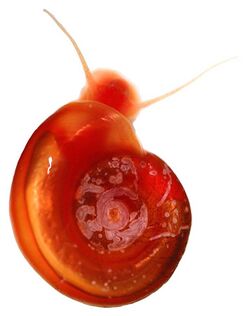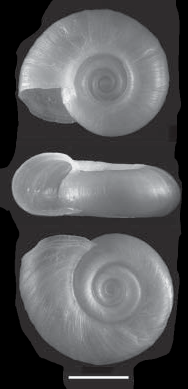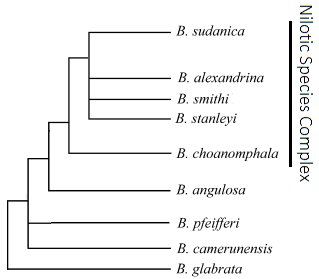Biology:Biomphalaria
| Biomphalaria | |
|---|---|

| |
| An albino individual of Biomphalaria glabrata | |
| Scientific classification | |
| Domain: | Eukaryota |
| Kingdom: | Animalia |
| Phylum: | Mollusca |
| Class: | Gastropoda |
| Subclass: | Heterobranchia |
| Superorder: | Hygrophila |
| Family: | Planorbidae |
| Subfamily: | Planorbinae |
| Tribe: | Helisomatini |
| Genus: | Biomphalaria Preston, 1910[1] |
| Type species | |
| Biomphalaria smithi Preston, 1910
| |
| Diversity[2] | |
| 34 species | |
| Synonyms | |
|
Taphius (H. Adams & A. Adams, 1855) Planorbis (Planorbina) (Haldeman, 1842) | |
Biomphalaria is a genus of air-breathing freshwater snails, aquatic pulmonates belonging to the family Planorbidae, the ram's horn snails and their allies.[3][4]
Biomphalaria is the type genus of the tribe Biomphalariini. Both Planorbis and Taphius are synonyms for Biomphalaria.[3][5]
The shell of this species, like all planorbids is left coiling (sinistral), but is carried upside down and thus appears to be right coiling (dextral).
Species
There are a suspected 35[6] extant species in the genus Biomphalaria in total (21 American species and 14 Old World species). However, there are a large number of invalid taxa within the Biomphalaria literature, which is likely the result of several (if not all) species of Biomphalaria being subject to various sources of intraspecific variation such as ecophenotypic variation and indeterminate shell growth.[7] This intraspecific variation can make two individuals of the same species appear as two taxonomically distinct entities when identified using only morphological identification methods.[8][9]
New World (South American) species include:
- Biomphalaria amazonica (Paraense, 1966)
- Biomphalaria andecola (d'Orbigny, 1835)
- Biomphalaria cousini (Paraense, 1966)[10]
- Biomphalaria edisoni (Estrada, Velásquez, Caldeira, Bejarano, Rojas & Carvalho, 2006)[11]
- Biomphalaria glabrata (Say, 1818)
- Biomphalaria havanensis (L. Pfeiffer, 1839)
- Biomphalaria helophila (d'Orbigny, 1835)
- Biomphalaria intermedia (Paraense & Deslandes, 1962)[12]
- Biomphalaria kuhniana (Clessin, 1883)
- † Biomphalaria manya (Cabrera & Martinez, 2018)[13]
- Biomphalaria obstructa (Morelet, 1849)
- Biomphalaria occidentalis (Paraense, 1981)[12]
- Biomphalaria oligoza (Paraense, 1974)[12]
- Biomphalaria orbignyi (Paraense, 1975)[12]
- Biomphalaria peregrina (d'Orbigny, 1835)[12]
- Biomphalaria prona (E. von Martens, 1873)
- † Biomphalaria reversa
- Biomphalaria schrammi (Crosse, 1864)
- Biomphalaria straminea (Dunker, 1848)[12]
- Biomphalaria subprona (Martens, 1899)[14]
- Biomphalaria temascalensis (Rangel-Ruiz, 1987)
- Biomphalaria tenagophila (d'Orbigny, 1835)[12]
Old World (Africa, Madagascar and the Middle East) species include:
Confirmed species using molecular identification methods:[15][16]
- Biomphalaria alexandrina (Ehrenberg, 1831)
- Biomphalaria angulosa (Mandahl-Barth, 1957)
- Biomphalaria camerunensis (Mandahl-Barth, 1957)
- Biomphalaria choanomphala (E. von Martens, 1879)
- Biomphalaria pfeifferi (Krauss, 1848)
- Biomphalaria smithi (Preston, 1910) - type species
- Biomphalaria stanleyi (Smith, 1888)
- Biomphalaria sudanica (Martens, 1870)
There is one known hybrid Biomphalaria glabrata × Biomphalaria alexandrina from Egypt.[17]
Suspected species identified using morphological methods:
- Biomphalaria arabica (Melvill & Ponsonby, 1896)
- Biomphalaria barthi (Brown, 1973)
- Biomphalaria rhodesiensis (Mandahl-Barth, 1957)
- Biomphalaria ruppellii (Dunker, 1848) - subspecies: B. ruppellii ruppellii; B. ruppellii katangae Haas[18]
- Biomphalaria salinarum (Morelet, 1868)
- Biomphalaria tchadiensis (Germain, 1904)
Phylogeny
A cladogram created from mitochondrial and nuclear DNA showing the phylogenic relationships of both New World (16) and Old World (7) species:[15]
| Biomphalaria |
| ||||||||||||||||||||||||||||||||||||||||||||||||||||||||||||||||||||||||||||||||||||||||||||||||||||||||||||||||||||||||||||||||||||||||||||||||
The topology was consistent with the proposed Neotropical origins of the genus, with the oldest Biomphalaria fossils being dated from approximately 60 million years ago.[7] However, further analysis of the African Biomphalaria species found only B. camerunensis and B. pfeifferi were the only definitive African species, with the remain species being a part of (or a sister taxa to) the "Nilotic species complex":[16]
All of the African Biomphalaria species have low levels of genetic diversity,[19][20] which is likely the result of their relatively recent evolutionary history.
Distribution
The origin of the genus Biomphalaria is American.[15] The ancestor of Biomphalaria glabrata colonized Africa 2.3–4.5[15] or 2-5[21] millions years ago and speciated into all the African Biomphalaria species.[15]
Natural populations of these snails are usually found in tropical standing water or freshwater in South America and Africa, but they also reach 30° latitude in subtropical areas. Many species of these red-blooded planorbid snails (Gastropoda: Basommatophora) are able to survive a long time when removed from their freshwater habitat. Of the 34 Biomphalaria species, 4 (Biomphalaria glabrata, Biomphalaria pfeifferi, Biomphalaria straminea, and Biomphalaria tenagophila) have recently expanded their native ranges. They have been introduced to areas where other Biomphalaria species are endemic (e.g., Congo and Egypt) or to subtropical zones that have no frost period (Texas, Louisiana, Florida, Hong Kong).[6]
All species in the genus Biomphalaria except of native Biomphalaria obstructa has not yet become established in the US, but they are considered to represent a potentially serious threat as a pest, an invasive species which could negatively affect agriculture, natural ecosystems, human health or commerce. Therefore, it has been suggested that this species be given top national quarantine significance in the USA.[22]
Parasites
This genus of snails is medically important, because the snails can carry a parasite of humans which represents a serious disease risk: the snails serve as an intermediate host (vector) for the human parasitic blood fluke, Schistosoma mansoni, that infects about 83 million people.[23]
The human disease schistosomiasis (aka snail fever) caused by all Schistosoma species (transmitted also by other snails) infects 200 million people.[24] The fluke, which is found primarily in tropical areas, infects mammals (including humans) via contact with water that contains schistosome larvae (cercariae) which have previously been released from the snail. Infection occurs via penetration of cercariae through the skin.[25]
Eighteen species of Biomphalaria are intermediate hosts for Schistosoma mansoni; seven species of the genus have not been tested for this susceptibility and nine species are resistant.[26] Altogether about 30 species of parasites from Africa and at least 20 species from the Neotropics are known to parasitize Biomphalaria.[26]
References
This article incorporates public domain text from the Majoros et al. reference.[2]
- ↑ Preston H. B. (1910) "Addition to the non-Marine Molluscan Fauna of British and German East Africa and Lake Albert Edward". The Annals and Magazine of Natural History including zoology, botany, and geology 6(8 series, 35): 526-. 535, plate IX figure 26, 26A.
- ↑ 2.0 2.1 Majoros, G. B.; Fehér, Z.; Deli, T.; Földvári, G. (2008). "Establishment of Biomphalaria tenagophila Snails in Europe". Emerging Infectious Diseases 14 (11): 1812–1814. doi:10.3201/eid1411.080479. PMID 18976582.
- ↑ 3.0 3.1 "WoRMS - World Register of Marine Species - Biomphalaria Preston, 1910". https://www.marinespecies.org/aphia.php?p=taxdetails&id=718742.
- ↑ Preston, H.B. (November 1910). "LX.—Additions to the non-Marine molluscan fauna of British and German East Africa and Lake Abert Edward". Annals and Magazine of Natural History 6 (35): 526–536. doi:10.1080/00222931008692885. ISSN 0374-5481. http://dx.doi.org/10.1080/00222931008692885.
- ↑ Bouchet P.; Rocroi J.-P. (2005). "Classification and Nomenclator of Gastropod Families". Malacologia 47 (1–2): 167–168.
- ↑ 6.0 6.1 Majoros, G. B.; Fehér, Z.; Deli, T.; Földvári, G. (2008). "Establishment of Biomphalaria tenagophila Snails in Europe". Emerging Infectious Diseases 14 (11): 1812–1814. doi:10.3201/eid1411.080479. PMID 18976582.
- ↑ 7.0 7.1 Jarne, Philippe; Pointier, Jena-Pierre; David, Patrice (2011), Toledo, Rafael; Fried, Bernard, eds., "Biosystematics of Biomphalaria SPP. With an Emphasis on Biomphalaria glabrata" (in en), Biomphalaria Snails and Larval Trematodes (New York, NY: Springer): pp. 1–32, doi:10.1007/978-1-4419-7028-2_1, ISBN 978-1-4419-7028-2, https://doi.org/10.1007/978-1-4419-7028-2_1, retrieved 2023-04-02
- ↑ Standley, Claire J.; Wade, Chris; Stothard, J. Russell (2011-10-24). "A Fresh Insight into Transmission of Schistosomiasis: A Misleading Tale of Biomphalaria in Lake Victoria". PLOS ONE 6 (10): e26563. doi:10.1371/journal.pone.0026563. ISSN 1932-6203. PMID 22046308.
- ↑ Zhang, Si-Ming; Bu, Lijing; Laidemitt, Martina R.; Lu, Lijun; Mutuku, Martin W.; Mkoji, Gerald M.; Loker, Eric S. (2018-05-09). "Complete mitochondrial and rDNA complex sequences of important vector species of Biomphalaria, obligatory hosts of the human-infecting blood fluke, Schistosoma mansoni". Scientific Reports 8 (1): 7341. doi:10.1038/s41598-018-25463-z. ISSN 2045-2322. PMID 29743617. PMC 5943310. http://dx.doi.org/10.1038/s41598-018-25463-z.
- ↑ Teodoro, T. M.; Janotti-Passos, L. K.; Carvalho, O. D. S.; Caldeira, R. L. (2010). "Occurrence of Biomphalaria cousini (Mollusca: Gastropoda) in Brazil and its susceptibility to Schistosoma mansoni (Platyhelminths: Trematoda)". Molecular Phylogenetics and Evolution 57 (1): 144–151. doi:10.1016/j.ympev.2010.05.019. PMID 20580934.
- ↑ Estrada, V. E.; Velásquez, L. E.; Caldeira, R. L.; Bejarano, E. E.; Rojas, W.; Carvalho, O. S. (2006). "Phylogenetics of South American Biomphalaria and description of a new species (Gastropoda: Planorbidae)". Journal of Molluscan Studies 72 (3): 221–228. doi:10.1093/mollus/eyl003.
- ↑ 12.0 12.1 12.2 12.3 12.4 12.5 12.6 Rumi A., Gregoric D. E. G., Núñez V. & Darrigran G. A. (2008). "Malacología Latinoamericana. Moluscos de agua dulce de Argentina". Revista de Biología Tropical 56(1): 77–111. HTM.
- ↑ Cabrera & Martinez (2018). "A new species of Biomphalaria Preston, 1910, Gastropoda Planorbidae, from the Upper Cretaceous of Uruguay". Revista Brasileira de Paleontologia.
- ↑ Paraense, W Lobato (1996). "Biomphalaria subprona (Martens, 1899) (Gastropoda: Planorbidae)". Memórias do Instituto Oswaldo Cruz 91 (2): 187–190. doi:10.1590/S0074-02761996000200011. PMID 8736087.
- ↑ 15.0 15.1 15.2 15.3 15.4 DeJong, Randall J.; Morgan, Jess A. T.; Paraense, W. Lobato; Pointier, Jean-Pierre; Amarista, Manuel; Ayeh-Kumi, Patrick F. K.; Babiker, Ahmed; Barbosa, Constança S. et al. (2001-12-01). "Evolutionary Relationships and Biogeography of Biomphalaria (Gastropoda: Planorbidae) with Implications Regarding Its Role as Host of the Human Bloodfluke, Schistosoma mansoni". Molecular Biology and Evolution 18 (12): 2225–2239. doi:10.1093/oxfordjournals.molbev.a003769. ISSN 1537-1719. PMID 11719572.
- ↑ 16.0 16.1 Jørgensen, Aslak; Kristensen, Thomas K.; Stothard, J. Russell (October 2007). "Phylogeny and biogeography of African Biomphalaria (Gastropoda: Planorbidae), with emphasis on endemic species of the great East African lakes". Zoological Journal of the Linnean Society 151 (2): 337–349. doi:10.1111/j.1096-3642.2007.00330.x. ISSN 1096-3642.
- ↑ Yousif, F.; Ibrahim, A.; Abdel Kader, A.; El-Bardicy, S. (1998). "Invasion of the Nile Valley in Egypt by a hybrid of Biomphalaria glabrata and Biomphalaria alexandrina, snail vectors of Schistosoma mansoni". Journal of the Egyptian Society of Parasitology 28 (2): 569–582. PMID 9707685.
- ↑ Brown, David S (1994-05-26). Freshwater Snails Of Africa And Their Medical Importance. CRC Press. doi:10.1201/9781482295184. ISBN 978-1-4822-9518-4. http://dx.doi.org/10.1201/9781482295184.
- ↑ Morgan, Jess A. T; DeJong, Randall J; Jung, Younghun; Khallaayoune, Khalid; Kock, Sonja; Mkoji, Gerald M; Loker, Eric S (2002-12-01). "A phylogeny of planorbid snails, with implications for the evolution of Schistosoma parasites" (in en). Molecular Phylogenetics and Evolution 25 (3): 477–488. doi:10.1016/S1055-7903(02)00280-4. ISSN 1055-7903. PMID 12450752. https://www.sciencedirect.com/science/article/pii/S1055790302002804.
- ↑ Van Damme, Dirk; Van Bocxlaer, Bert (2009), Dumont, Henri J., ed., "Freshwater Molluscs of the Nile Basin, Past and Present" (in en), The Nile: Origin, Environments, Limnology and Human Use, Monographiae Biologicae (Dordrecht: Springer Netherlands) 89: pp. 585–629, doi:10.1007/978-1-4020-9726-3_29, ISBN 978-1-4020-9726-3, https://doi.org/10.1007/978-1-4020-9726-3_29, retrieved 2023-04-02
- ↑ Morgan, J. A. T.; Dejong, R. J.; Snyder, S. D.; Mkoji, G. M.; Loker, E. S. (2003). "Schistosoma mansoni and Biomphalaria: Past history and future trends". Parasitology 123 (7): S211–28. doi:10.1017/S0031182001007703. PMID 11769285./
- ↑ Cowie R. H., Dillon R. T., Robinson D. G. & Smith J. W. (2009). "Alien non-marine snails and slugs of priority quarantine importance in the United States: A preliminary risk assessment". American Malacological Bulletin 27: 113-132. PDF .
- ↑ Crompton, D. W. (1999). "How much human helminthiasis is there in the world?". The Journal of Parasitology 85 (3): 397–403. doi:10.2307/3285768. PMID 10386428. http://www.healthmanager.ru/files/helminths.pdf.
- ↑ The Carter Center "Schistosomiasis Control Program". Accessed 20 November 2009.
- ↑ Colley, Daniel G; Bustinduy, Amaya L; Secor, W Evan; King, Charles H (June 2014). "Human schistosomiasis". The Lancet 383 (9936): 2253–2264. doi:10.1016/s0140-6736(13)61949-2. ISSN 0140-6736. PMID 24698483. PMC 4672382. http://dx.doi.org/10.1016/s0140-6736(13)61949-2.
- ↑ 26.0 26.1 Dejong, R. J.; Morgan, J. A.; Paraense, W. L.; Pointier, J. P.; Amarista, M.; Ayeh-Kumi, P. F.; Babiker, A.; Barbosa, C. S. et al. (2001). "Evolutionary relationships and biogeography of Biomphalaria (Gastropoda: Planorbidae) with implications regarding its role as host of the human bloodfluke, Schistosoma mansoni". Molecular Biology and Evolution 18 (12): 2225–2239. doi:10.1093/oxfordjournals.molbev.a003769. PMID 11719572., text.
Further reading
- Baker F. C. (1945) The molluscan family Planorbidae. Urbana, The University of Illinois Press, page 89
- (in Portuguese) Brasil. Ministério da Saúde. Secretaria de Vigilância em Saúde. Departamento de Vigilância Epidemiológica. (2007) Vigilância e controle de moluscos de importância epidemiológica : diretrizes técnicas : Programa de Vigilância e Controle da Esquistossomose (PCE). Ministério da Saúde, Secretaria de Vigilância em Saúde, Departamento de Vigilância Epidemiológica. 2. ed. Brasília : Editora do Ministério da Saúde. 178 pp. ISBN:978-85-334-1438-9. (Surveillance and Control of Mollusks with Epidemiological Importance: technical directives: Schistosomiasis Control and Surveillance Program)
- Chapter: Aquaculture and schistosomiasis. In: Larsson B. (December 1994) Three overviews on environment and aquaculture in the tropics and sub-tropics. ALCOM (Aquaculture for Local Community Development Programme) Field Document No. 27, 52 pp.
- Plam, M.; Jørgensen, A.; Kristensen, T. K.; Madsen, H. (2008). "Sympatric Biomphalaria species (Gastropoda: Planorbidae) in Lake Albert, Uganda, show homoplasies in shell morphology". African Zoology 43: 34–44. doi:10.3377/1562-7020(2008)43[34:SBSGPI2.0.CO;2]..
External links
Wikidata ☰ Q3075178 entry
 |



